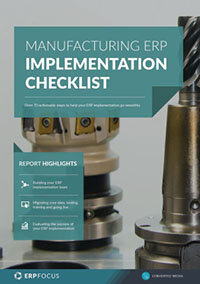When to install an APS on top of your ERP (and when not to)
The benefits of deploying a fully integrated manufacturing ERP system to manage your production are huge: better management of your bill of material (BoM), tracking of your stocks and inventory in one system, optimization of your resources’ utilization…
Though manufacturing-oriented ERPs have multiple advantages, they often fail to respond to a specific need in the manufacturing process, and that is production planning. Some companies can live with it and plan their production on a whiteboard for instance. But others have such a complex planning process that it soon creates an unmanageable machine of procedures no one fully controls.
While the ERP system is convenient for managing ongoing operations and records all activities as they happen, planning and forecasting processes are decision-support processes that focus on the future. Quite often, the ERP will miss the functionality to efficiently assist production planners in their decision-making steps. That's when they start using a spreadsheet on the side. And when that spreadsheet becomes too big and complex, it's time to bring advanced planning and scheduling (APS) in the picture.
What APS software can do for you
An APS tool is designed to support complex planning processes and integrate the results efficiently into your ERP. Advanced planning and scheduling software capabilities allow you to take multiple parameters into account, optimize, and revise your production schedule in a matter of minutes. It enables you to find stock excess situations, identify bottleneck work centers, reduce machine setup time, quote a delivery date for a new customer order based on your capacity, etc.
Let’s say a machine in your assembly line breaks down. This has an impact on your work in progress, other customers’ orders, promised delivery dates, and ultimately customers’ satisfaction and retention. The same goes for a rush order of 50,000 units coming in. How do you insert it in today’s schedule with minimal impact on other manufacturing orders?
The question sounds simple but can be very hard to answer because it requires to have a helicopter view on your materials capacity (i.e. the components of your BoM that you have in stock), resources capacity (i.e. how much your machines can handle and who in your staff is available), overall timeline, full list of sales orders, manufacturing orders, purchase orders (without even mentioning the delays your suppliers might cause), etc.
If you can handle this by switching between different screen views or features in your ERP system, then you probably don’t need to enhance your production planning ritual with APS. If you need to extract multiple datasets from your ERP, apply rocket science formulas, spread them across 7 Excel spreadsheets each having 38 tabs, which takes 2 hours to compute… then you should consider boosting your planning productivity and bandwidth with an APS.
How to integrate APS to your ERP system
Integrating an APS into your ERP system is much easier than it sounds. There is no need for a consultants-heavy 6-month project. Technically, the operation is quite simple. Functionally, several points of attention may arise during the project.
One of them is your data structure. You need to map out your supply and manufacturing operations to identify the various connections in your chain and make sure to integrate all the actors and components that will influence your plan. In practice, your plan will only be valid if it mirrors the complexity of reality.
Here are some examples of the multiple parameters you should pay attention to: staff aptitude and authorization to operate on specific machines, staff shifts and holidays, raw materials suppliers and stocks, lead time of each job, machine changeovers, alternate resources (i.e. when several machines can do the same task and you can alternate between them), packaging, safety regulations, etc.
If you can retrieve this information in the various parts of your ERP and connect it to the APS, then the integration is fast and straightforward.
How about you?
Long story short, if you can generate a production plan in your ERP without getting into many complex manipulations, you probably don’t need APS. If you need to extract files from your ERP to perform extra computations in spreadsheets and re-enter the computed plan manually, then an APS is recommended.
Free white paper

Manufacturing ERP Implementation Checklist
Over 70 actionable steps to rolling out new manufacturing ERP software

Related articles
-

How to Develop an ERP Failure and Recovery Plan
Learn how you can develop a recovery plan to safeguard against the prospect of ERP failure.
-

Secret KPI: Why Your ERP Implementation Team Matters More Than Software
Learn how Godlan ensures successful ERP implementation for manufacturers with proven strategies &...
-

How to Plan Your ERP Integration
Learn about the tricks of the trade when it comes to ERP integration from our expert ERP project ...

